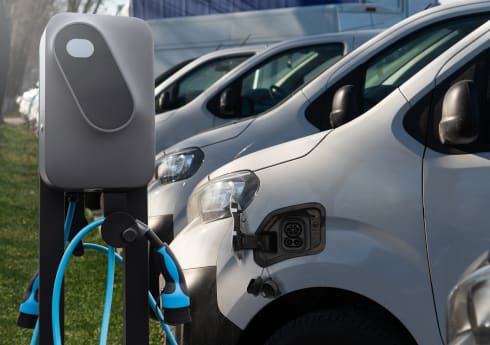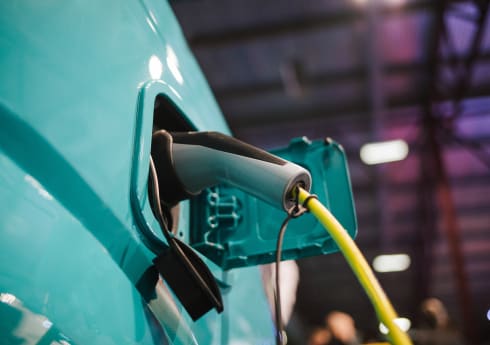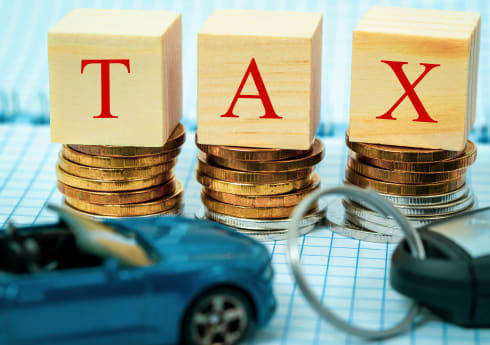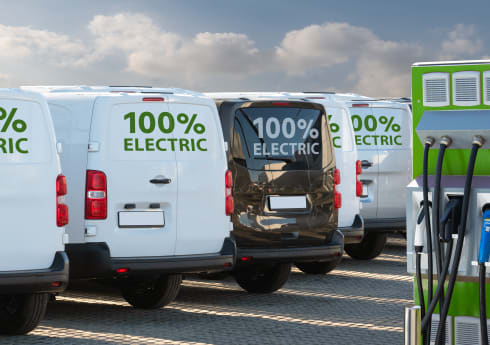Losses During EV Battery Charging Guide
When you use a charge point with your electric vehicle, some energy is lost. Losses during EV battery charging aren’t a disaster. But understanding where it goes can help you to maximise your EV’s battery life.
In this feature, we cover everything you need to know about what gets lost and why. Plus, you can compare the market for the most efficient charging points in the UK.

Understanding losses during EV battery charging
Okay, we’re here to break down what’s going on with that energy loss. Whether you’re using a workplace EV charging station or a home-based EV charging station, there will be energy losses whenever you charge.
A bit annoying, right? So, let’s look at where those losses are taking place.
What are EV battery charging losses?
As energy moves from the charging point to an EV, some of it is lost as the energy changes from one form to another.
With an EV, the electricity is converted into chemical energy. With an AC charger, you’ll lose energy because of the:
- Onboard charger.
- Cable.
- Charging power.
- EV battery.
- Weather.
Now, we’ve got a handy breakdown of each one of those. This’ll show you exactly where that electricity losses are going.
1. Onboard charger losses
With current EV models, even the most advanced ones like Tesla and Lucid Air, the main energy losses come from the onboard charger. Most of these units are 75%-95% efficient, so the losses you’ll experience will depend on the manufacturer you use.
What this unit does is convert AC (alternating current) to DC (direct current) power. When that happens it produces heat (which is why, on a different charging front, your laptop gets warm during a charge).
EVs combat the heat by using cooling devices—usually water. While that stops your EV from overheating, it doesn’t stop some losses during EV battery charging.
2. Charging cable losses
You’ll lose more energy through your charging cable. Whether you’re using a tethered or untethered charging point doesn’t matter. What does make a difference is the length of the cable.
The shorter the charging cable, the lower the resistance, and that means you’ll lose less power. This doesn’t mean you should hunt down a tiny cable to maximise your energy savings, it’s just something to think about when deciding on a charging point.
3. Charging power losses
If you’re running a high power charging station, then that’ll generate more heat (and energy losses). A solution? Well, you should turn to a thick charging cable.
That’ll cut down on excessive heat.
If you’ve got a superfast charging speed (e.g. 22kWh), then you should get the thickest possible cable you can get.
Many providers of charging stations, or cables, have specially designed products for just that. If you want to charge at 22kWh, then make sure you match the right cable with the charging speed.
4. Battery losses
Electric vehicles (whether you have a car or van) use lithium-ion batteries. When they convert electricity into chemical energy, then you’ve got the usual energy loss through heat.
Most EV models these days have a thermal temperature management system readymade with the battery, which is designed to limit your losses.
But you can make a difference by charging your EV on a lower setting. If you ramp it up to the highest charging speed, you’re always going to lose more energy (and cost yourself more money).
5. Weather losses
There are two weather extremes that’ll affect charging losses:
- Freezing winter days: This causes charging to slow down as the EV battery has to warm up before it can start to charge.
- Hot summer days: These aren’t good for EV batteries as they can overheat. Although most models will have an inbuilt cooling system, you can also help by keeping your EV in the shade.
Some EV batteries also have pre-conditioning options letting you warm up the battery before you start charging. That can help you limit losses and degeneration of the unit.
Are EV battery charging losses a big problem?
No, not really. The good news is the extra energy isn’t going to cost you a bundle. Consider it like this:
- You use 15% more energy on your 60kWH charge to an EV.
- That amounts to 9kWh.
- The result is less than £1 in extra energy.
Which, depending on petrol/diesel rates, is about one-third of the cost of traditional fuels. Turn that into a 20,000 mile drive each year and it’s not even £80.
It’s not ideal, of course, but keep in mind using an EV saves you on ULEZ congestion charges in London. Plus, you’ll save money on maintenance in the long-term.
How to monitor losses during EV battery charging
If you want, you can keep track of your energy losses while charging. How do you do that? Well, you can:
- Charge your EV from a low battery level to a high one (say, 35%-85%) and check how much power was in use.
- Run the data you have alongside EV battery capacity.
- The difference you get is the charging loss.
The most accurate way to do this test is to charge from 0%-100%, but that’ll cause battery degeneration if you do that. We advise you don’t!
You can’t really do much about them and it’s just a part of electric vehicles as they are right now. Although, having said that, you can save a few tricks up your sleeve.
How to prevent losses during EV battery charging
While you can’t stop most of the energy losses, there are a few steps you can take to help out your EV battery efficiency:
- Onboard charging systems don’t work efficiently if you’re running a very low current into them.
- Don’t charge your EV on a high-speed charger. Try to limit it to standard charging as much as possible, otherwise you ramp up the pressure on your electricity grid.
The good news is there are other steps you can take to preserve EV battery life and make the most of the power available to you.
We have a full guide to the best EV battery charging practices to follow. If you keep the guidelines there in mind, you’ll stop battery degeneration and stay on the move for longer.
iCompario tip: Use EV vehicle hire to meet your eco-friendly goals
EV, batteries, environment… it can be tricky to stay on top of everything if you have an EV. But one way to ensure you’re environmentally friendly is by turning to EV vehicle hire. Instead of buying an EV outright, you can rent one for as long as you need it.
Or you can add to your existing fleet with flexible or long-term contracts! It saves you money and provides your business with the very best EV models to match your business needs.
Will EV battery losses always be a problem?
Yes, more than likely. There’ll always be a small amount of energy lost even a decade from now. But the technology is improving hand-over-fist all the time.
In 10 years, the losses will be much more minor. Manufacturers will be mastering new techniques over the years ahead and it’ll make a big difference.
But even now, the losses are nothing to panic about.
If you’re worried about the environmental damages of these losses, they’re nothing compared to jumping into a petrol-driven vehicle to head off for a business meeting. That causes far more pollutants.
Also, in the future, solid-state EV batteries are likely to be a game-changer. These aren’t available in EVs at the moment, but manufacturers such as Honda are working on them. Its plan is to launch them later in the decade (around 2028).
Manufacturers are set to use solid-state units into the space where lithium-ion batteries would normally be. With these, the polymer substrate in current EV batteries is replaced by solid substrate. And that’ll increase energy capacity and range.
It’s a way off yet, but an exciting prospect all the same for the industry.
How long do EV batteries last?
Most EV drivers can expect an EV battery life of 200,000 miles, depending on the type of EV you drive. In most cases, the battery will outlive the vehicle you have.
EV battery life will continue to get better and better. The technology is advancing rapidly, so you can expect some batteries to last from 15-20 years in cars and vans.
Are EV batteries sustainable?
Yes, in the sense there are enough raw materials around for lithium, cobalt and nickel batteries long into the future. What’s crucial to the future of EV batteries is recycling.
While new technologies may emerge in the future for better battery units, for now it’s essential for EV battery sustainability to recycle retired units. Millions of them will retire over the next decade—what happens to them is more important. If they end up in a landfill for the rest of eternity, it’s not a good look for the EV industry.
And the great news is EV batteries are incredible for recycling potential.
In fact, some 95%+ lithium-ion battery components can be taken out of a used EV battery and put to use again (a fancy process called hydrometallurgy).
The pollution caused by this recycling process is very low.
But are EV batteries bad for the environment? The environmental impact of lithium mining is considerable when factoring in the use of water. This can be as high as 250 gallons of water per pound of lithium removed from salt flats.
And there is a drawback to recycling them—the amount of recycling facilities is quite low. There’s going to be a massive influx of used EV batteries in the coming years as the popularity of the vehicles goes up.
The industry will have to move fast to ensure EV battery sustainability. It’s much like research ongoing with synthetic fuels in the road car industry right now. The possibilities are there, it’s just the clever engineering minds need to refine this pioneering technology a little more.
Get setup with the ideal EV charging point
Got all the knowledge you need? Ready to charge your electric vehicles with the best possible charge point set up? All you need to do is search the market:
- Enter a few business details.
- We’ll find deals to match your needs.
- Pick from your recommendations.
That’s it! It’ll save you a bunch of time and money, directing you straight to the charge point provider best suiting your business’ needs.



